

This section contains the following topics:
Implementation Planning Overview
Identify the Applications to Secure
Identify Authentication Methods
Identify Password Management Options
Identify Who Will Manage Your Web Agents
Identify Resources to be Secured with Multiple Cookie Domains
Determine if Partnerships Require CA SiteMinder® Federation
Determine if Advanced Encryption Standards are Required
Determine if Virtualization is to be Used
Determine how to Manage Policy Servers
Determine how to Manage Web Agents
The decisions related to how you implement CA SiteMinder® depend on:
We recommend that you consider the information in this section before you deploy and configure CA SiteMinder®.
CA SiteMinder® policy management models let you define access permissions for web resources and their respective user populations. A policy management model establishes the following:
All CA SiteMinder® functionality is available, regardless of which model you use. The primary difference between the models is the level of CA SiteMinder® knowledge required to configure each. The following Administrative UI objects represent the policy management models:
Note: The following CA SiteMinder® core objects are required to configure an application object or domain policy:
Note: For more information about these objects, see the Policy Server Configuration Guide.
Application objects provide an intuitive method of defining a complete security policy for a web application, website, or web service. Applications associate resources with user roles to specify entitlement policies that determine what users can access what resources.
Note: An application object defines policy information that can otherwise be configured in a policy domain and its subobjects. That is, realms, rules, rule groups, responses, and policies. The following table summarizes this relationship.
|
Application Dialogs and Group Boxes |
Equivalent Domain Component |
|---|---|
|
General settings |
Policy domain and the root location of the protected resources. |
|
Components |
Realm and the location of the resources within the application that share the same security requirements. |
|
Resource |
Rule and the required authentication or authorization actions. |
|
Application Roles |
User directory lookups. |
Note: For more information about policy management using applications, see the Policy Server Configuration Guide.
Before SiteMinder r12.0, policy domains and domain objects (realms, rules, responses, policies, and so on) were the only way to protect resources. For Policy Server administrators already comfortable with them, policy domains and domain objects can still be used to configure security policies for resources.
A CA SiteMinder® policy is comprised of the following individual CA SiteMinder® objects:
A policy object binds these core objects to identify resources, user populations, and the required actions when CA SiteMinder® grants or denies access to the resource. As such, configuring a CA SiteMinder® policy requires an understanding of each object.
Note: For more information about each of these objects and their individual CA SiteMinder® policy roles, see the Policy Server Configuration Guide.
Which applications are you planning to secure? How do they map to the CA SiteMinder® access management models?
Begin thinking about the individual applications in the organization and the individual resources (URLs) within each application that require the same level of protection. We recommend identifying the following:
Grouping resources in this way helps you map applications to the CA SiteMinder® access management models.
When gathering information about each application, use a resource table similar to the following to help organization information:
|
Resource |
Domain/Application Resource Filter |
Realm/Component Resource Filter |
|---|---|---|
|
Example: Corporate Portal |
Example: Performance Management application |
Example: Manager resources |
Note: Identifying the applications that require protection also aids in capacity planning.
Defining a CA SiteMinder® policy domain or an EPM application depends on identifying logical groups of resources, often an individual application, that are associated with one or more user populations. Grouping resources at this level helps you to identify the sets of individual resources (URLs) within an application that share the same security requirements.
Note: For more information about a CA SiteMinder® policy domain or an EPM application, see the Policy Server Configuration Guide.
A strategy for determining these requirements is to review a site map of the organization.
For example, a fictitious company, has a corporate intranet that the following site map represents:

In this example, the corporate portal is separated into the following logical groups of resources:
The resource table for the corporate intranet looks like the following:
|
Resource |
Domain/EPM Application Filter |
Realm/Component Filter |
|---|---|---|
|
Corporate Intranet |
intranet.example.com |
N/A |
|
Learning |
intranet.example.com/learning |
N/A |
|
Performance Management |
intranet.example.com/performance |
N/A |
|
Support |
intranet.example.com/support |
N/A |
|
Business Tools |
intranet.example.com/tools |
N/A |
|
Corporate |
intranet.example.com/corporate |
N/A |
Defining a CA SiteMinder® policy realm or an EPM component depends on identifying sets of individual resources (URLs) that share the same security or personalization requirements within a CA SiteMinder® policy domain or EPM application. The contents of a realm or EPM component share the same authentication scheme. As a result, identifying these resources early in the process can help you determine the authentication schemes required to meet individual security requirements.
Note: For more information about CA SiteMinder® policy realms and EPM components, see the Policy Server Configuration Guide.
For example, although the Performance Management and Business Tools applications each let a specific user population access the root of the application, each application contains additional CA SiteMinder® policy realms or EPM components to provide a level of security or personalization appropriate for the resource:
Note: Although not illustrated, CA SiteMinder® policy rules and EPM resources are used to control specific Web Agent, authentication, and authorization events. For more information, see the Policy Server Configuration Guide.
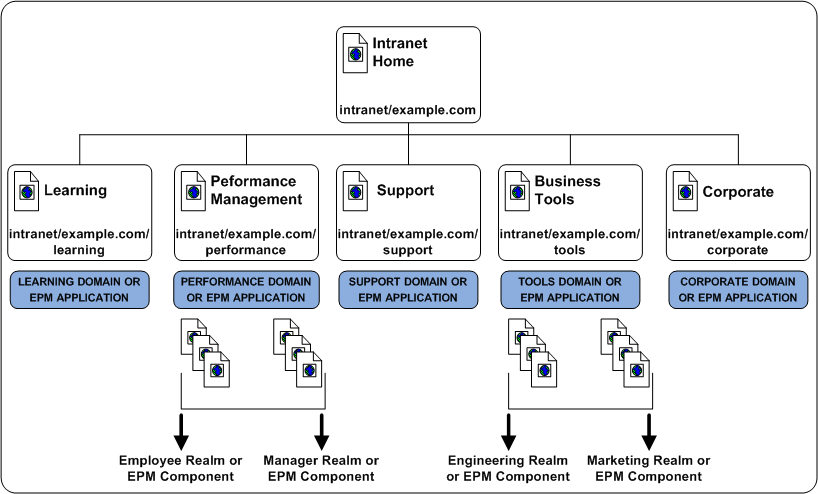
The resource table for the applications looks like the following:
|
Resource |
Domain/EPM Application Filter |
Realm/Component Filter |
|---|---|---|
|
Corporate Intranet |
intranet.example.com |
N/A |
|
Learning |
intranet.example.com/learning |
N/A |
|
Performance Management |
intranet.example.com/performance |
/employee /manager |
|
|
|
|
|
Support |
intranet.example.com/support |
N/A |
|
Business Tools |
intranet.example.com/tools |
/engineering /marketing |
|
|
|
|
|
Corporate |
intranet.example.com/corporate |
N/A |
CA SiteMinder® can authenticate and authorize users through one or more connections to existing user stores in your enterprise network. After you identify the applications to secure, consider the following questions:
Identifying the stores each application uses helps you to:
Note: For more information about configuring user store connections within a domain, see the Policy Server Configuration Guide.
Note: For more information about directory mapping, see the Policy Server Configuration Guide.
When gathering information about each application, use a table similar to the following to organize information:
|
User Store Name |
User Store Type |
Authentication? |
Authorization? |
|---|---|---|---|
|
|
|
|
|
|
|
|
|
|
|
|
|
|
|
|
|
|
|
|
CA SiteMinder® supports multiple authentication methods to meet the varying levels of protection your resources require:
|
|
|
|
|
|
|
|
|
|
After you identify the applications to secure, in which we recommend identifying sets of resources (URLs) that share the same security requirements, consider the following questions:
Answering these types of questions helps you to
Note: For more information about configuring authentication schemes, see the Policy Server Configuration Guide.
When gathering information about each resource, we recommend organizing your information by the applications you plan on securing. For example, the following table assumes that an application is grouped into individual domains and realms, as detailed in applications to secure.
|
Resource |
URL |
Realm |
Authentication Method |
|---|---|---|---|
|
|
|
|
|
|
|
|
|
|
|
|
|
|
|
|
|
|
|
|
|
|
|
|
|
|
|
|
|
|
Do any security policies require your organization to manage user passwords? Do you anticipate managing user passwords in the future?
You can use CA SiteMinder® password policies to enforce the password requirements of your enterprise. A password policy can validate the user's password against any of the following types of characteristics before accepting it:
Verifies the minimum or maximum length, the types of characters allowed, and if or how often any of those characters can be repeated in a password.
Verifies the time limits for how long the same password can be used, how long a password can remain inactive before it must be changed, and how long or how often before an expired password can be reused. You can specify one of the following responses for users with expired passwords:
Records the number of times the user has previously entered an incorrect password, and takes one of the following actions when that number is exceeded:
Note: For more information, see the CA SiteMinder® Policy Server Configuration Guide.
If you plan to implement password policies in your enterprise, consider the following:
Otherwise the native password policy accepts or reject passwords without notifying CA SiteMinder®. Consequently, CA SiteMinder® cannot manage those passwords.
Note: For more information, see the CA SiteMinder® Policy Server Configuration Guide.
Web Agents connect to a Policy Server upon startup. The Policy Server contains an Agent Configuration Object (ACO), which directs the associated Web Agent to the location of its configuration parameters.
How your applications are deployed throughout your organization can help you determine the most efficient method of storing the configuration parameters for your CA SiteMinder® Web Agents. Consider the following questions:
If you answered yes to questions one or two in the previous list, try the following configuration method:
Manages the parameters for one or more agents from an agent configuration object (ACO) that resides in the Policy Server. With a central agent configuration, you can update the parameter settings of several agents at once. Generally, each distinct web application uses a separate ACO, whose settings are shared among all the agents that protect the web application. For example, if you have five agents protecting one accounting application, you can create one ACO with the settings that you want for the application. All five agents would use the parameter settings from the same ACO.
For different applications, we recommend using separate agent configuration objects. For example, if you want to protect a human resources application with stricter security requirements, create a separate ACO for the human resources application.
When an agent starts, it reads the AllowLocalConfig parameter values of its associated ACO. When the value is set to no, then the agent uses the parameter settings from the ACO (except the agent log and trace file settings). Agent log files and trace files can always be controlled locally, regardless of ACO settings.
Note: We recommend using central agent configuration (wherever possible) because it simplifies agent configuration and maintenance.
If you answered yes to questions three or four in the previous list, try the following configuration method:
Manages each Web Agent individually using a file installed on the web server itself. When a Web Agent starts, it reads the value of the AllowLocalConfig parameter of its associated Agent Configuration Object (ACO). If the value is set to yes, then the Web Agent uses the parameter settings from LocalConfig.conf file on the web server. The parameter settings from the LocalConfig.conf file override any settings stored in an ACO on the Policy Server.
Note: For more information about the location of the LocalConfig.conf file on your respective web server, see the Web Agent Configuration Guide.
The following questions can help you identify other situations where local agent configuration better serves the needs of your enterprise:
For example, you want to protect your internal resources with a large group of Web Agents, while implementing reverse-proxy servers in a few locations. You can use local configuration to manage the reverse-proxy Web Agents.
For example, your organization uses CA SiteMinder® to manage and enforce security policies, but allows web server administrators in remote offices to customize their log on and log off pages. You can add individual parameters to the value of the AllowLocalConfig parameter of the ACO to allow the administrators to change only those settings for the customized pages but no others.
Note: For more information, see the Web Agent Configuration Guide.
You can also use a combination of central and local configuration to meet your needs. For example, you can manage three similar web servers with central configuration, while managing the other two servers with local configuration. See the following illustration for an example:
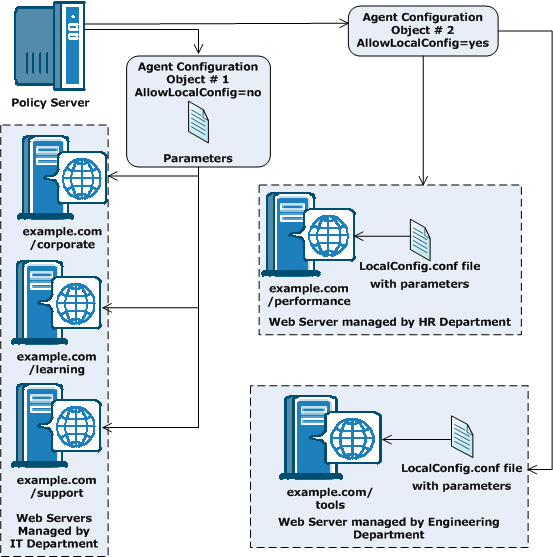
Multiple factors, which are discussed later, can influence how you decide to implement CA SiteMinder® components across multiple data centers. Identifying the data centers and the purpose each is to serve in your CA SiteMinder® environment prepares you to make informed decisions when determining how to implement CA SiteMinder® components. Consider the following questions:
When gathering information about each data center, use a resource table similar to the following to organize your results:
|
Data Center Name |
Location |
Purpose |
|---|---|---|
|
|
|
|
|
|
|
|
|
|
|
|
|
|
|
|
Will the single-sign on environment in your enterprise extend across multiple cookie domains?
CA SiteMinder® implements single sign-on across multiple cookie domains using a CA SiteMinder® Web Agent configured as a cookie provider.
The cookie domain where the cookie provider Web Agent resides is named the cookie provider domain. All the other Web Agents from the other cookie domains within the single sign-on environment, point to one cookie provider.
The following illustration shows an example of an SSO environment using multiple cookie domains:
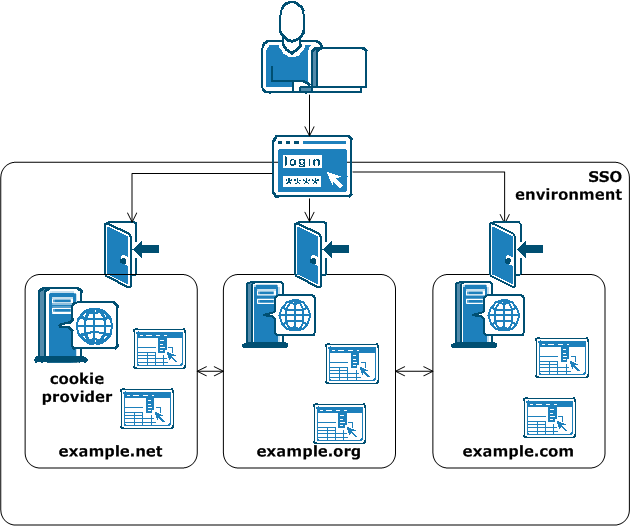
Note: For more information about cookie providers, see the Web Agent Configuration Guide.
Will the Agents in your single-sign on environment use load-balancing?
All agents in an SSO environment must refer to a single cookie provider domain. Add a load-balancer between the web servers in your cookie provider domain and the other cookie domains in your SSO environment. The following illustration shows an example:
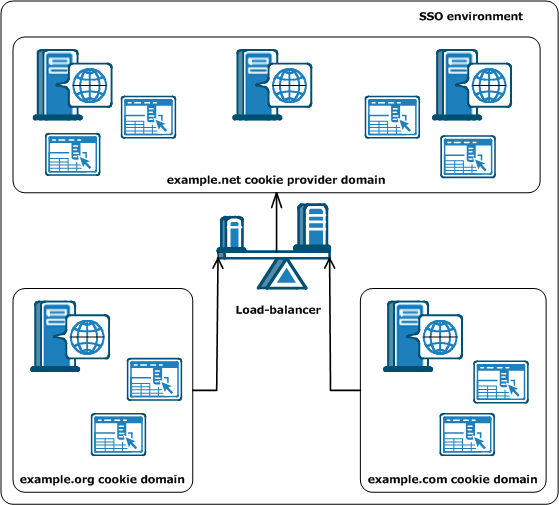
The Web Agent in the example.org cookie domain points and the Web Agent in the example.com cookie domain both point to the same cookie provider domain of example.net. A load-balancer distributes the traffic evenly between all the web servers in the example.net cookie provider domain.
Do existing or planned business-to-business (B2B) partnerships require your organization to share identity information securely with partners?
CA SiteMinder® Federation lets you extend CA SiteMinder® functionality to partner sites by enabling identity federation. CA SiteMinder® Federation offers two deployment options: legacy federation and partnership federation.
Federated transactions between partner organizations let your enterprise:
CA SiteMinder® Federation lets your enterprise generate, consume, or generate and consume assertions. CA SiteMinder® Federation supports the following standards and protocols:
Note: CA SiteMinder® Federation is separately licensed from CA SiteMinder®. Contact your CA account representative for more information about licensing. For more information about federation, see the CA SiteMinder® Federation Legacy Federation Guide or the CA SiteMinder® Federation Partnership Federation Guide.
If your organization plans on implementing federation, use a table similar to the following table to identify partners and the possible methods for enabling identity federation.
|
Partner |
Standard |
Protocol |
|---|---|---|
|
|
|
|
|
|
|
|
|
|
|
|
Does your organization require the use of Federal Information Processing Standard (FIPS) 140–2 compliant algorithms?
The CA SiteMinder® implementation of the Advanced Encryption Standard (AES) supports the FIPS 140–2 standard. FIPS is a US government computer security standard used to accredit cryptographic modules that meet the AES.
The Policy Server uses certified FIPS 140–2 compliant cryptographic libraries. These cryptographic libraries provide a FIPS mode of operation when a CA SiteMinder® environment only uses AES–compliant algorithms to encrypt sensitive data. A CA SiteMinder® environment can operate in one of the following FIPS modes of operation.
Note: For more information about the cryptographic libraries CA SiteMinder® uses and the AES algorithms used to encrypt sensitive data in FIPS–only mode, see the Policy Server Administration Guide. For more information about the FIPS modes of operation and which to use when installing the Policy Server, see the Policy Server Installation Guide.
If you are implementing AES encryption through FIPS-only mode, consider the following:
Note: For more information about your vendors ability to support the FIPS 140–2 standard, see the vendor-specific documentation.
Important! An environment that is running in FIPS–only mode cannot operate with and is not backward compatible to earlier versions of CA SiteMinder®. This requirement includes all agents, custom software using older versions of the Agent API, and custom software using PM APIs or any other API that the Policy Server exposes. Re–link all such software with the 12.52 versions of the respective SDKs to achieve the required support for FIPS–only mode.
Will CA SiteMinder® be implemented to a virtual environment?
Consider the following before implementing CA SiteMinder® to a virtual environment:
Note: For more information about performance tuning the virtual environment, see the vendor–specific documentation.
Should individual business units be responsible for managing Policy Servers? Or can a single business unit manage all Policy Servers centrally?
If individual business units manage Policy Servers and policy stores locally, consider that local Policy Server management:
Note: The illustration details a shared key store to depict a single sign–on requirement. A shared key store is not the only way to implement single sign–on and additional requirements exist. For more information about key management scenarios to facilitate single sign–on, see the Policy Server Administration Guide.
The following illustration details two business units managing Policy Servers locally:

If a single business unit is to manage Policy Servers centrally, consider that central Policy Server management:
Note: As illustrated, individual business units can continue to manage the CA SiteMinder® Agents protecting their applications.
The following illustration details a single business unit managing all Policy Servers:
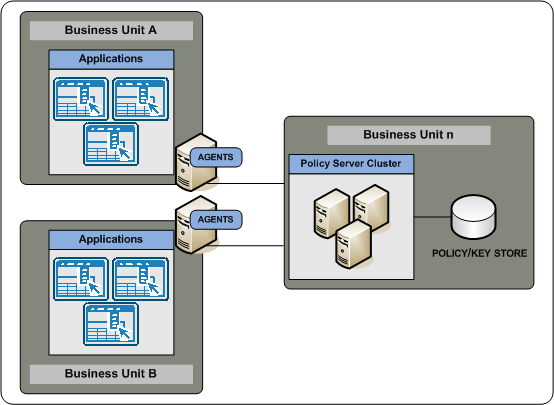
If you have several Web Agents which will all be configured identically, then using an Agent Configuration object on the Policy Server will make managing your Web Agents easier. A single Agent configuration object can be shared among an unlimited number of Web Agents. Configuration changes made on the Policy Server are automatically applied to any Web Agents which use the configuration object.
Note: For more information, see the Web Agent Configuration Guide.
|
Copyright © 2013 CA.
All rights reserved.
|
|